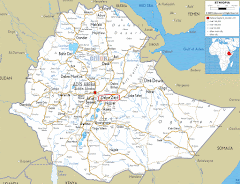What a pleasure it has been to live on the campus of Meserete Kristos Seminary and eat my meals with students each day in the dining hall. Another great pleasure has been interacting with the dining hall staff. I met these women my very first day on campus when I knew only a few words of Amharic and was eager to practice. That first day, I learned each of their names, and in the next week or two, a bit about them. I learned to ask, Where were you born? Do you have children? How old is your daughter or son? How many brothers and sisters do you have? (In the photo above are Asnakech, Tigist, Teje, Mulu, Mekdes, Mulu, Tagu, Tadu, Tiruye, and Meseret.)
Tagu, Tiruye, Tadu, and Mulu
Meserete and Mekdes
These women work hard! Every day they peel onions and garlic, bring wood from the wood pile and stoke the fire, make stews and injera, serve 200 students three times a day, and wash dishes. Pictured directly above are Askala and Diribe.
Injera is the staple of the day. This spongy pancake is made from the Ethiopian-grown grain called teff (and water). Yeast lives on teff’s surface, so the sourdough naturally ferments in one to three days.
In the “injera bet,” which literally means “injera house,” Asnakech and Tigist make about 200 injeras a day, measuring 22 inches in diameter. They work with four electric griddles for about five hours, using a straw mat to lift the injera off the griddle.
In the “wat bet,” or "stew house," the cooks prepare the stews of the day. Pictured here are Teje, Mulu, Meseret, and Tadu.
They use yellow split peas, brown lentils, red lentils, and chickpeas roasted and ground into a powder for traditional “shiro wat.” (Above chickpeas dry in the sun outside the dining hall, with the kitchen off to the right.) These stews are rotated throughout the week. Bob knows how much I love legumes and never seem to get enough. Well here in Ethiopia, I have my fill!
The stews are either “red” or “white.” Pictured above is one of each. Red stews are made with the signature Ethiopian spice blend called “barbare,” a mix including chili peppers, ginger, cinnamon, cardamom, and other spices, (depending on family preferences).
Once a week, on
Mondays, we have a “red” stew with ox meat, a nice break from the usual fare. It’s
served with a “white” potato stew.
Ours is a one-dish meal, eaten with your right hand. Ethiopian children learn at age 3 or 4 to soak the injera with the wat, working it with their fingers, and scoop it up into their mouth. My skills are weak, but I keep trying! I keep eating!
Four times a week we have pasta and eat with a fork (Friday dinner and Tuesday, Thursday, and Sunday lunch). Our menu is the same each week. The sauce is made from tomatoes, onions, garlic, and grated carrots. The spaghetti is served with vegies on the side—cooked cabbage, cooked potatoes and beets, or raw tomatoes—the rare raw vegetable we have.
We have water to drink and no dessert—no fruit, no sweets. An Ethiopian American friend of mine says, “How could you have room for dessert after filling up on injera?” She’s right—it is filling. It’s also nutritious. The grain teff has the essential amino acids, so it's a great source of protein, as well as magnesium, potassium, fiber, and iron.
Once or twice a week (and every breakfast), I eat at home—when my tummy needs a break from injera, or I don’t feel like eating with my hand, or I need some alone time. But mostly, mealtimes in the dining hall are a great pleasure! I love the simplicity and the social time.
I also love Tagu, the head cook. She has a special skill in helping me with Amharic, explaining things in a simple way without using any English. She’s been at MKS 21 years, first working in the “wat bet,” then the “injera bet,” and now as head cook. I leave Ethiopia at the end of this week. I will surely miss Tagu and her wonderful team. What a privilege it has been to get to know them and become friends.




















No comments:
Post a Comment